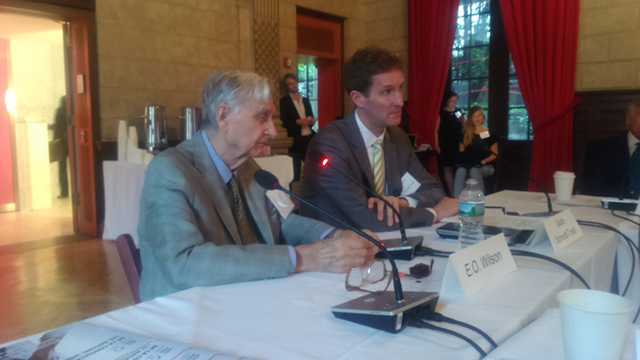

Photograph by Jess Espey
On September 19, 2016, E.O. Wilson spoke with the United Nations Sustainable Development Solutions Network (UN SDSN) about Half-Earth. Professor Wilson was a guest of Jeffery Sachs, the special advisor for the Sustainable Development Goals for the UN SDSN, and a member of the EOWBF Board of Advisors. The Sustainable Development Goals are a science-based approach to tackling the environmental problems currently facing the planet, and include the monitoring of large protected habitats and changes in forest cover.
Founded in 2012, the UN SDSN works “to mobilize global scientific and technological expertise to promote practical problem solving for sustainable development, including the design and implementation of the Sustainable Development Goals.” During the September 19th meeting, the members discussed Sustainable Development Goals 14 and 15, regarding ocean and land conservation. Conservation of life in the sea and on land are two of the 17 goals developed by the Network to provide a holistic framework in which the world can continue sustainable growth.
Watch an excerpt of E.O. Wilson’s talk at the UN SDSN
Video by Elena Crete
Goal 14. Conserve and sustainably use the oceans, seas and marine resources for sustainable development.
Goal 15. Protect, restore and promote sustainable use of terrestrial ecosystems, sustainably manage forests, combat desertification, halt and reverse land degradation and halt biodiversity loss.
—Sustainable Development Goals
Half-Earth was warmly received by SDSN members, and several praised the importance of this solution to protect the environment for future generations. Half-Earth promises to be an excellent goal for the UN SDSN to pursue as they work to protect habitats and the biodiversity that depends on them.


Photograph by Angelo Riccabonip
“Why One-half? Why not one-quarter or one-third? Because large plots, whether they already stand or can be created from corridors connecting smaller plots, harbor many more ecosystems and the species composing them at a sustainable level. As reserves grow in size, the diversity of life surviving within them also grows.”
—E.O. Wilson, Half-Earth

